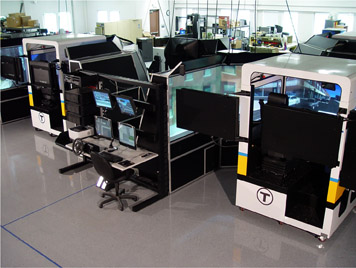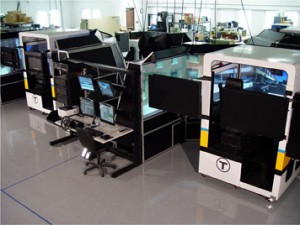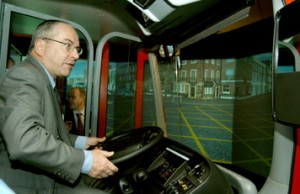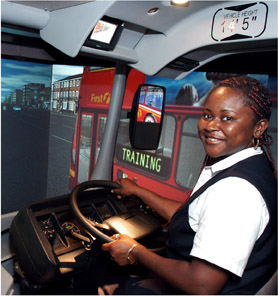
FAAC driver simulators improve performance and lower incident rates
by David Hubbard

FAAC entered the transit industry the day MTA New York City Transit (NYCT) recruited the company to adapt its simulator training concepts to train urban bus operators. The high degree of interactivity of the computer-generated imagery (CGI) intrigued the Department of Buses Safety and Training Division at a time the agency was under heavy public scrutiny for a recent spike in accidents. The chief training officer saw the simulator supplementing tradition training with additional seat time in a risk-free virtual environment focused on high-risk events.
NYCT and FAAC formed a public/private partnership to develop the first full-mission MB-2000-V8 Municipal Bus Simulator. The company went one step further equipping the simulator with physical mirrors to incorporate critical training tasks associated with setup, leaning technique, scanning frequency and managing the pivot point during turns or when overtaking fixed and moving objects. FAAC unveiled this simulator at the 1999 APTA Expo in Orlando, FL.
NYCT then conducted a pilot program to evaluate the effectiveness of the simulator. Prior to the simulator training, NYCT says the most prevalent type of collision was contact along the right side of the bus with a moving vehicle.
NYCT randomly selected one out of four students to receive two 30-minute sessions on the simulator with an emphasis on mirror usage, protecting the right side of the bus, and forward planning. FAAC says the simulator-based group of new hires performed better than expected. The participants experienced an incident rate 43 percent better than those trained without the simulator. Their washout rate also showed a 35 percent improvement.

“Most importantly of the 177 graduates trained on the simulator not one experienced a right side accident during their 90-day probationary period,” says Steve Mentzer, FAAC manager, transit simulations. “We hit the mark.”
NYCT purchased three additional units to ensure new hire candidates would all receive the benefits of simulator-based driving lessons.
The NYCT pilot program convinced FAAC its new product supported the training initiatives of this agency. But according to Mentzer the company couldn’t be sure if this simulator would serve the rest of the industry in a similar manner.
“We decided the best way assess its potential would be to enlist the services of training professionals from other organizations,” says Mentzer. “As luck would have it the Transportation Research Board was about to release a study on simulation before the MB-2000 had been unveiled. The author of the TCRP study happened to see our simulator and asked us to arrange a demonstration.”
Mentzer enlisted APTA members to help FAAC organize its initial Industry Advisory Group (IAG), which effectively became a steering committee to help guide and direct the on-going improvement of the MB-2000. Based on its recommendations FAAC made ensuing changes to combat the most prevalent safety concerns and promote the best training practices. It added such items as Ped Pilot, a joystick function that enables an instructor to control the initial placement and subsequent movement and behaviors of a virtual pedestrian; the DT-1000 Multi-Purpose Desktop, which allows the instructor to manipulate an observation deck to show any desired orientation of the trainee vehicle and also operate another vehicle to interact directly with students; and convex mirrors. From its further involvement with the IAG and the transit industry it added a host of instructor-initiated events, equipment malfunctions and other transit-specific features.
 FAAC has since replaced the IAG with input from the growing customer base and on-line presence, its in-house subject matter and training specialists, as well as its annual user conference.
FAAC has since replaced the IAG with input from the growing customer base and on-line presence, its in-house subject matter and training specialists, as well as its annual user conference.
Mentzer says today the MB-2000 simulator is in service at respected bus properties across North America as well as London Bus in the UK.
Rochester-Genesee RTA trains remedially
Rochester-Genesee RTA, Rochester, NY, implemented the FAAC simulator to address post-incident training, an area of emphasis in the agency.
Veteran drivers charged with an incident received remedial training for one year in two groups: one on the simulator, the other by traditional classroom-based methods. The results showed a 5 percent accident rate from post-incident training for the simulator–trained operators compared to the 39 percent accident rate of non-simulator trained operators.
Paducah Area Transit System hits the road
The Paducah Area Transit System (PATS) operates a mobile training classroom outfitted in an elaborate semi rig to deliver instruction directly to the doorsteps of rural transit properties and school districts throughout the state.
 The mobile classroom is equipped with six kiosks, a cutaway van simulator, a municipal bus simulator and a transit police simulator.
The mobile classroom is equipped with six kiosks, a cutaway van simulator, a municipal bus simulator and a transit police simulator.
Since simulator training began in 2006 the total number of accidents dropped 44 percent from FY 2006 to 2007. PATS reported the training reduced preventable accidents by 64 percent.
“Our transit customers use our simulators to promote basic skill development and teach the driving formulas that are core to a safe and efficient bus operation,” says Mentzer. “They also use our simulators to conduct return to work refreshers, annual certification training, CDL exam training and effective corrective action lessons to operators involved in collisions with fixed objects, pedestrians or other vehicles.”
Flexible enough for all
As a flexible training solution for multi-modal agencies, FAAC can customize its products for a variety of transit vehicles with various power sources —standard diesel, hybrid, electric, CNG and propane. The simulator can accommodate training on cutaway body on chassis paratransit vehicles with functional wheel chair lifts, as well as shuttles and electric trolleys that draw power from overhead wires.
FAAC users report reductions of preventable accidents by as much as 64 percent. In addition, the training has significantly reduced critical risk exposures that often result in personal injury claims, such as accidents involving bicyclists.
The Scenario ToolBoxTM Script Authoring Software can be used to develop custom, repeatable training lessons with specific maneuvers instructors can define to accomplish specific learning objectives.
“We believe a focused approach toward application of the simulator is the best return on investment for prospective agencies,” says Mentzer. “We maintain a staff of in-house experts and support personnel an agency can rely as members of their training and risk management teams.” BR
Simulator preliminaries to consider
Simulators should be used as a supplemental tool to reinforce an existing operator training curriculum.
Simulators enable trainees to practice difficult maneuvers in the safety of the classroom.
Simulators are not meant to replace seat time on an actual bus or coach, but their proper use can reduce fuel and related training costs.
Simulators offer the opportunity to reinforce specific learning objectives with practical lessons that mimic actual driving maneuvers.
Student drivers are allowed to make mistakes in the virtual environment as part of the learning process.
Simulators can present scripted or randomly occurring traffic conditions.
